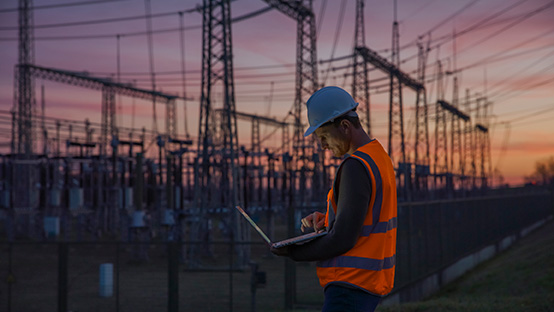AI is transforming utility disaster readiness, helping predict risks, accelerate restoration and strengthen long-term resilience.
By Eric Young, Director of Grid Management and Distributed Intelligence at Itron
Severe weather events have become a major challenge for utilities, with power outages caused by extreme conditions nearly doubling in the past decade. Hurricanes, wildfires, persistent below freezing temperatures in the south and heatwaves everywhere are testing the limits of existing grid infrastructure, pushing utilities to rethink how they respond to disasters and build resilience into their systems. Traditional methods, such as physical patrols and human-driven response efforts, can now be augmented or replaced with new technology that helps contain costs with increasing frequency and intensity of these events. As the challenges grow, so does the need for this new technology that enables a faster, more efficient response.
Artificial intelligence (AI) is emerging as a critical tool for utility disaster preparedness. With a comprehensive approach that integrates grid edge intelligence, advanced metering infrastructure (AMI) and distributed intelligence (DI), AI is transforming how utilities prepare for, respond to and recover from disasters. Here’s how AI is reshaping disaster readiness in the utility sector.

AI’s effectiveness relies on high-quality, real-time data from the grid’s edge. Technologies like DI-enabled smart meters, IoT sensors and distributed automation devices provide detailed data on energy flow, load fluctuations, impedance and reactive power conditions, while also capturing environmental factors such as temperature and humidity. DI-enabled AMI systems further enhance this by enabling localized analytics and decision-making, allowing utilities to process and exchange critical data between field devices and central operations in near real-time.
With AI-powered predictive analytics, utilities can identify potential vulnerabilities and take preemptive action. By analyzing historical outage data, real-time grid conditions and weather forecasts and patterns, AI can pinpoint areas at risk during storms and severe weather. For example, predictive models can assess where tree overgrowth near power lines may increase the likelihood of outages or where aging infrastructure is more prone to failure under stress. In wildfire-prone areas, IoT sensors deployed near power lines can detect heat, smoke or unusual atmospheric changes. AI analyzes this data to flag risks, enabling proactive measures to prevent a fire from starting or spreading.
Once a disaster occurs, utilities must quickly assess the damage and deploy resources where they are needed most. AI streamlines this process, reducing response times and improving restoration efforts in the following ways:
After a major outage, restoring service quickly is a top priority. AI enhances every stage of this process, modeling data to simulate different recovery scenarios to determine the fastest way to bring power back online. These models can prioritize critical infrastructure such as hospitals, emergency response centers and water treatment facilities, ensuring essential services remain operational.
Additionally, AI-driven automation allows utilities to quickly reconfigure distribution networks to isolate faults and reroute power, minimizing the number of affected customers. In Louisiana, one utility recently implemented AI-enabled AMI technology that helps predict and prevent outages. The system has already avoided over 48,000 outage minutes by identifying risks and taking corrective action before failures escalate.
Beyond immediate disaster response, AI is becoming an essential tool in long-term grid resilience planning. AI can identify weak points in the grid, such as deteriorating infrastructure or high-risk vegetation zones, allowing utilities to strategically invest in upgrades that reduce outage risks and prevent unexpected equipment failure during extreme weather events. AI also helps utilities integrate and manage DERs, such as microgrids and battery storage, to provide backup power during outages. By predicting demand, assessing resource availability and coordinating DER activation in real time, AI ensures these assets are used effectively to support grid stability.
Extreme weather events will continue to challenge the resilience of the power grid. However, AI offers utilities a transformative way to anticipate, respond to and recover from disasters with greater speed and precision. By taking it a step further with grid edge intelligence integration, utilities can move beyond reactive approaches and adopt proactive, data-driven strategies that improve reliability, reduce downtime and enhance customer confidence. As AI continues to evolve, its role in disaster preparedness and grid resilience will only become more essential—helping utilities build smarter, more adaptable energy systems for the future.

About the Author:
Eric Young is the Director of Grid Management and Distributed Intelligence at Itron, where he oversees Itron’s grid edge intelligence products and the development of use cases that enable automated system operations. With over two decades of experience in electric utility solutions, his role is centered on helping utilities adopt innovative, data-driven approaches to improve reliability, safety and efficiency.
In this episode, I sat down with Beejan Giga, Director | Partner and Caleb Emerson, Senior Results Manager at Carpedia International. We discussed the insights behind their recent Industry Today article, “Thinking Three Moves Ahead” and together we explored how manufacturers can plan more strategically, align with their suppliers, and build the operational discipline needed to support intentional, sustainable growth. It was a conversation packed with practical perspectives on navigating a fast-changing industry landscape.